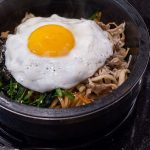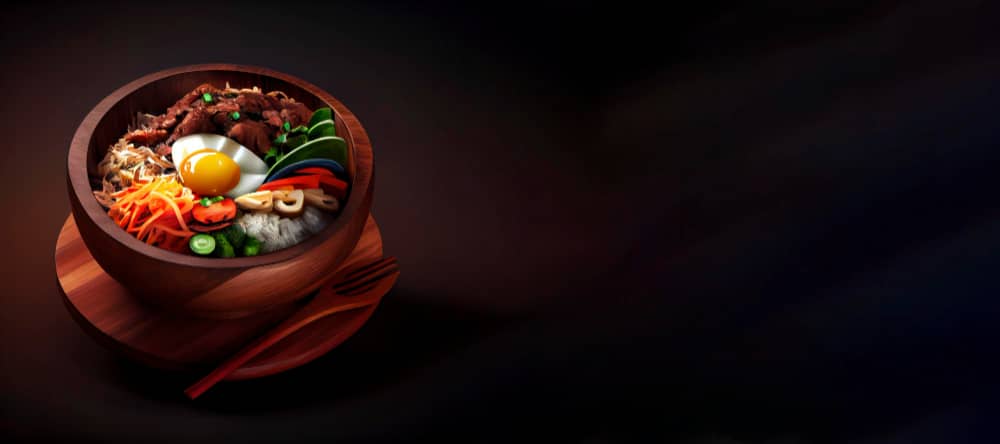Bibimbap is a bowl of warm rice topped with seasoned vegetables, and it is traditional Korean healthy food. It’s a hearty and delicious meal that can be enjoyed any time of day. If you’re looking for a Bibimbap recipe to try at home, look no further!
This traditional Korean meal consists of a bowl of warm rice topped with seasoned vegetables like carrots, cucumber, spinach, and bean sprouts. The dish can be served with meat or tofu and is often garnished with a fried egg or spicy sauce.
Despite being loaded with different ingredients, bibimbap is considered healthy food for its high nutritional value.
The vegetables used in bibimbap are often nutrient-dense like carrots, spinach, bean sprouts, and mushrooms. Bibimbap can be also rich in protein because it can be added beef or chicken as a main ingredient. This combination of carbohydrates (rice), fiber (vegetables), and protein added to the bibimbap recipe makes it an ideal meal for fitness enthusiasts and those who want to maintain a healthy lifestyle. Moreover, the spicy chili paste called gochujang used in bibimbap is known to boost metabolism and reduce inflammation.
Print
Bibimbap Recipe
- Total Time: 1 hour 20 minutes
- Yield: 2
Description
Bibimbap is a delicious and nutritious dish that has been enjoyed in Korea for generations.
Ingredients
- 2–3 cup Rice
- 60 g Carrot
- 2 leaf Cabbage
- 6 leaf Lettuce
- 2 Eggs
- 1 tsp Sesame Seeds
- 2 sheets gim
- 2 cup soybean sprouts
- 4 shiitake mushrooms
- 1 tsp sesame oil
Gochujang Sauce
- 4 tsp gochujang
- 2 tsp soy sources
- 2 tsp garlic
- 1 tsp sugar
- 1 tsp vinegar
- 1 tsp sesame oil
- 1 tsp Sesame Seeds
Instructions
- Wash 2-3 cups of rice, put the rice in a thick cooker, add 1 cup of water and boil them.
- Cut zucchini, carrots, shiitake mushrooms, cabbage, lettuce and gim into thin slices (Match stick size).
- Add 1 teaspoon of sesame oil to frying pan on medium heat. Place in carrots and season with salt, then cook fast for 30-40 seconds to remove moisture and stay color vivid.
- Repeat this pan-frying for the zucchini and mushrooms as well.
- Place cooked rice in a deep bowl and add the prepare ingredients on top of the rice.
- Fry an egg sunny-side-up in a frying pan and place it on top of the ingredients.
- Mix all ingredients well and add seasoned gochujang before eating.
- Prep Time: 30
- Cook Time: 50
- Category: Main Dish
- Cuisine: Korean
Bibimbap Recipe FAQs
How long is bibimbap good for?
When it comes to how long bibimbap will stay good for, it depends on the ingredients used and how it is stored. If you make bibimbap with fresh ingredients and store it in the refrigerator in an airtight container, it should stay good for 3-4 days. If you make bibimbap with cooked ingredients such as leftovers from other meals, then it should last up to 5-6 days in the refrigerator.
If you plan on freezing bibimbap, make sure all the ingredients are cooked before freezing. When properly stored in an airtight container, frozen bibimbap can last up to 3 months. To thaw frozen bibimbap, place the container in the fridge overnight or microwave until heated through.

Is bibimbap recipe healthy or not?
The healthiness of bibimbap can vary depending on how it is prepared. If it is made with white rice instead of brown rice or with too much oil or gochujang sauce then it may be higher in calories and unhealthy saturated fats. Therefore, if you are looking to make bibimbap healthier you should opt for brown rice and use less oil or sauce when preparing it.
What do Koreans eat with bibimbap?
Koreans typically eat bibimbap with a variety of side dishes, including kimchi, doenjang jjigae (fermented soybean stew), and namul (seasoned vegetables). A popular condiment for bibimbap recipe is gochujang, a spicy red pepper paste. It adds flavor and heat to the dish. Additionally, some restaurants may offer other side dishes such as jeon (Korean pancakes) or dubu-kimchi (tofu and kimchi).
When served in a traditional setting, bibimbap is usually accompanied by several banchan, or small side dishes that are served in small portions. These can include jorim (braised vegetables), oi sobagi (stuffed cucumber kimchi), gyeran mari (rolled egg omelette), yachae muchim (seasoned vegetables), and many more.
What is the Korean jelly in bibimbap?
Korean jelly in bibimbap is a type of gelatinous food made from agar, a type of seaweed. It is usually served in small cubes or strips and has a soft, chewy texture. The jelly is often flavored with soy sauce, sesame oil, garlic, and other seasonings. In traditional bibimbap recipe, the jelly is added to the dish along with other ingredients such as vegetables, beef, and an egg.
The jelly helps to add texture and flavor to the dish while also helping to bind all of the ingredients together. It can be enjoyed either hot or cold and makes for a unique and delicious addition to any bibimbap meal.
What alcohol goes with bibimbap?
Bibimbap is a traditional Korean dish that is usually served with rice, vegetables, and meat. The best alcohol to pair for your bibimbap recipe would be a light beer or soju. Light beers such as lagers or pilsners are the perfect accompaniment to this dish as they won’t overpower the flavors of the food. Soju is a popular Korean spirit that pairs well with bibimbap due to its clean, crisp flavor. It also helps to cut through the richness of the dish and can help bring out the flavors of the ingredients. Both light beer and soju are excellent choices for pairing with bibimbap!
Disclaimer
The information contained in this post is for general information purposes only. These statements have not been evaluated by the FDA and are not intended to diagnose, treat, cure or prevent any disease or health condition. If you have specific healthcare concerns or questions about the products displayed, please contact your licensed healthcare professional for advice or answers.

